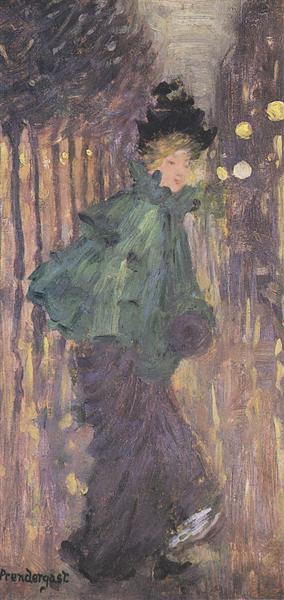Description
The lady of the boulevard, painted in 1892 by Maurice Arrendast, is a work that encapsulates the spirit of modernity at the end of the 19th century, standing out for its special use of color and compositional virtuosism. Prendergast, an outstanding member of the American impressionist movement, transmits in this piece a vibrant sensation and an atmosphere of urban life that evoke both beauty and effervescence of life in large cities.
He painting It presents an elegantly dressed woman who walks through a wooded boulevard, suggesting a social narrative without revealing concrete details, which allows the viewer to project her own ideas and feelings on the scene. The central figure dresses with a white dress that highlights its presence and becomes a focal point before the surrounding landscape. The choice of soft and bright colors, combined with a light and loose line, shows the characteristically impressionist technique of Prendastg, which seeks to capture light and movement rather than a strict representation of the form.
The color palette is particularly rich and luminous, with predominance of green and blue that combine with the whiteness of the lady's dress, creating a contrast that not only attracts her eyes, but also brings a visual balance to the composition. The warm shades that make up the vegetation and the urban environment are intertwined with the coldest tones, conferring to the work an atmosphere of peace and harmony, emblematic of the urban landscapes that I was admired so much. This sophisticated use of color is not only framed in the aesthetics of impressionism, but also anticipates certain explorations of Fauvism that would arise in later decades.
The background of the painting, composed of an amalgam of subtle forms and colors that exhibit the movement of the city, suggests an active social life and a dynamism that enters dialogue with the central figure. Although there are no other characters that compete with the lady, the assumption that the urban environment is full of life remains in force. Trees and buildings draw a scenario designed in which passers -by move almost organically, contributing to the meaning of a place where modernity and nature coexist in a single plane.
Prendergast, who was influenced by artists such as Pierre-Auguste Renoir and Édouard Manet, moved away from the most traditional representations, choosing, instead, a form of expression that connects the everyday with the sublime. This approach led him to explore various themes linked to urban life, particularly in his scenes of parks and boulevards, where people congregate and experience social life in its maximum expression. In the lady of the boulevard, Purgast synthesizes this vision through a figure that, although lonely in the image, seems to encapsulate the essence of the social encounter and the scented experience of urban walks.
In conclusion, the lady of the boulevard invites us to reflect on the time, beauty and social environment of the late nineteenth century, a moment of intense changes. Through its distinctive technique, Arrentgast not only documes a moment, but also creates an emotional experience that resonates with the notion that each walk through the boulevard is, in some way, a dance with life itself. This work, in its conjunction of colors and its contemporary theme, not only highlights the mastery of Maurice Prengast as a painter, but also his acute observation of the evolving world that surrounded him.
KUADROS ©, a famous paint on your wall.
Hand-made oil painting reproductions, with the quality of professional artists and the distinctive seal of KUADROS ©.
Art reproduction service with satisfaction guarantee. If you are not completely satisfied with the replica of your painting, we refund your money 100%.

